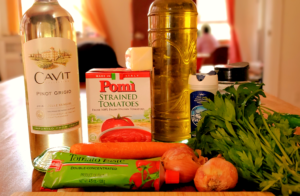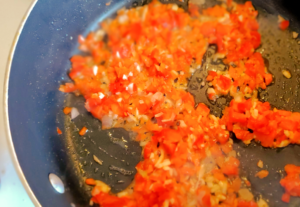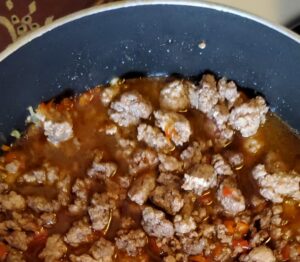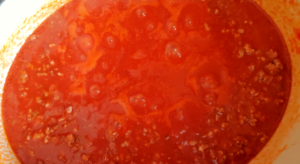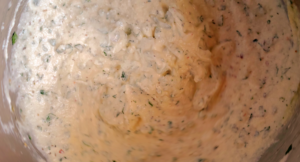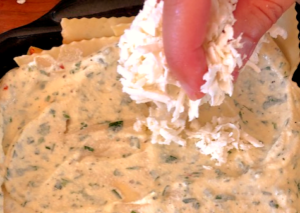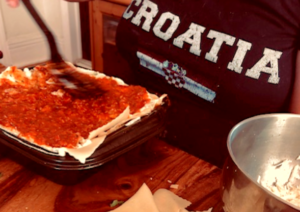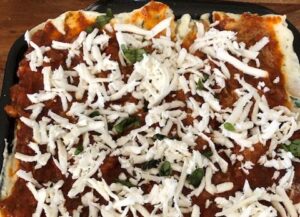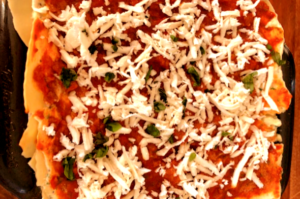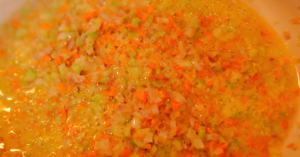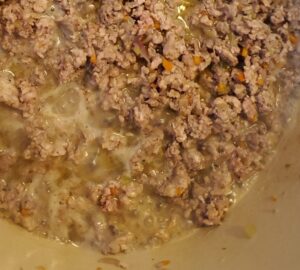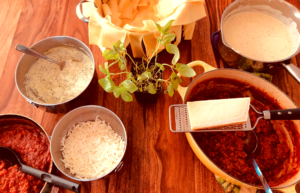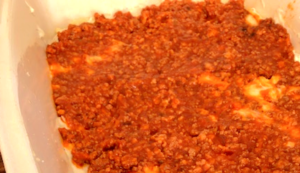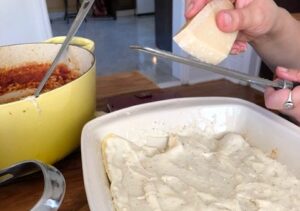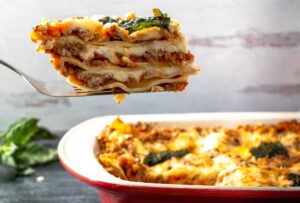Napoli vs. New York Lasagna
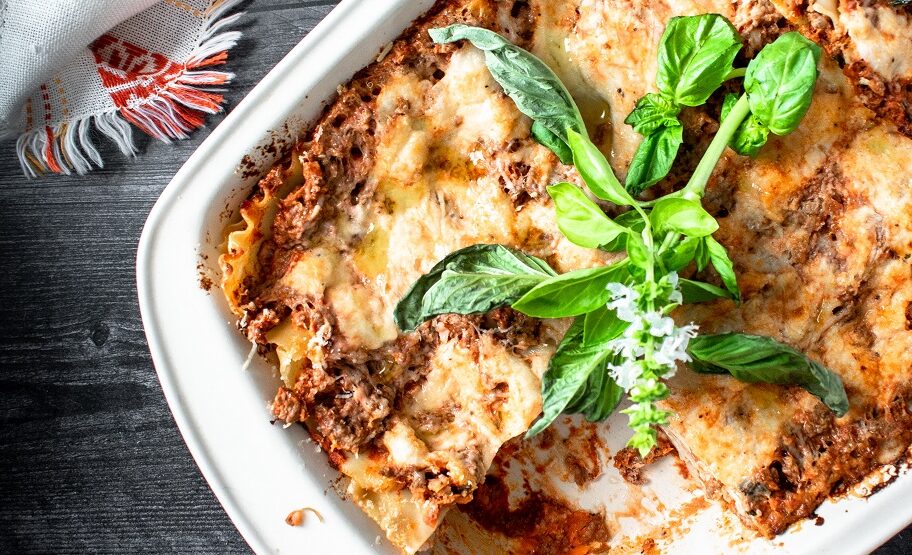
A History of Lasagna
Growing up in Westchester, my Queens-Croatian mother made lasagna on the regular. It was delicious, and most fondly remembered in the 1980’s. Ronzoni lasagna sheets that she draped over the sides of the tall pasta pot to dry out after cooking, her usual “meat sauce” that was a basic Bolognese with ground beef, and sometimes ground pork thrown in, and a combination of ricotta and mozzerella to provide the cheesy glue. It was comforting, filling, and dependable.
In my adulthood, I spent my 20’s and much of my 30’s eating lasagna in New York City. For a time, I enjoyed the white tiles, Croatian waiters (masquerading as Italians as they sometimes do), and tourist friendly meat lasagna of Luna’s in Little Italy. The lasagna was more garish, like an oversized slice of New York pizza. Piled high, the meat glistened with more fat than my mother’s and the golden mozzarella layer on top was like a comfy down blanket wrapped lovingly around the brick of pasta.
In my 30’s, I frequented many places around Manhattan and Brooklyn, one of which has now disappeared from 2nd avenue somewhere between 1st and 8th street in the East Village. The lasagna there was thoughtful, with its distinct and slightly creamier cheese layers. Since then, I became obsessed with separating the ground meat from the red sauce, and adding fresh basil.
Brooklyn Nights
After years living in Brooklyn, my good friend Suzan introduced me to Tommaso’s, a so-classic-you-can-call-it-vintage New York Italian place, complete with snarky bartender (“Hey, you look like that Nadia G. you know, Bitchin’ Kitchen!”), Christmas decorations shoved with care into every crevice in the place as if someone’s grandmother was an employee, and, sometimes, an elderly gentleman piano player who sang Christmas carols with a neon orange haired woman by his side.
I reserved eating there for the pre-Christmas holiday season, since Tommaso’s was then at its best. One season, I ordered the lasagna, only to be surprised in this classic joint with a deconstructed lasagna. The layers were spread about the plate, and the cheese component tasted smoother, milkier, as if it might not have been ricotta based.
While not my favorite structure of lasagna, I thought about that Tommaso’s rich cheese taste that poked its head into my imagination while dinner deep in Brooklyn.
So here we are…over the years, I’ve kept tabs of these additional elements of the lasagna, from homemade pasta sheets to a less garlicky sauce, to the mysterious cheese mixture that bound the layers together later in my lasagna seeking missions.
I did some research on the origins of the Lasagna. It made sense that it originated from Italy. Some said medieval Naples, others Emilia-Romagna. However, I didn’t think to find lasagna (or lasagne) in Ancient Greece as “Laganon” (referring to the strips of pasta). In fact, the flavors of the continental Italian lasagna reflects more a Greek Pasticcio, which has built-up layers of tube pasta, bechemel, and hints of nutmeg. On top of that, there are records for lasagna in Britain dating back to the late 1300’s…I’m not drowning in that cheese-filled rabbit hole.
Lasagna Throwdown
Let’s keep it simple. Napoli vs. New York. Old World vs. New City style lasagna.
On a Saturday a few weeks back, I decided to make both.
Because of my extensive history with New York lasagna, I decided to make a smaller version of the NY style and a big pan of the Napoli style (also called Lasagna Bolognese).
The two ragus both had the basic meat mixture of two parts ground beef to one part ground pork. The NY ragu I prepared was not the one I had made over the years from a Sicilian cookbook, which was normally a spartan combination of robust garlic, crushed tomatoes and seasoning. Of late, I enjoyed the more subtle flavors of an onion base with red pepper (my Croatian-ness reared it head), and garlic. Additionally, I began adding some carrot for a more grounded flavor. Slowly I was heading for Naples…
The base of the Napoli Lasagna is a basic mirepoix–onion, celery, carrot. The ground meat mixture is added into the pan. The NY ground meat is browned with red wine; the Napoli meat with white wine. The nature of the tomatoes differs in texture and so the ragus each have their own distinct feel. The thicker, chunkier NY sauce vs. the smoother, sweeter Napoleanic one.
The biggest difference is in the cheese:
The NYC version, at least the ones I’m used to, a ricotta layer — my mother combined ricotta with a couple eggs for creaminess, along with salt, black pepper, red pepper, and ample parsley–and a separate mozzarella layer. The Napoli old world style uses a simple Bechemel sauce, along with a modest amount of Parmigiano-Reggiano.
The result? I can’t lie. The Napolean Lasagna blew me away. It’s the case of meeting a suave new European. They can’t help but appear dangerous and exciting to my New York eyes and taste buds. The creaminess of the bechemel layer reminded me of a Mac and Cheese fornicating somewhat romantically with an Italian lasagna. My fork slipped through the layers like butter, and I happily ate leftovers, both warmed and cold, all week long.
As I frolicked away with my new continental favorite, my roots spoke up in the form of a voice in the back of my head. They reminded me that, in fact, New York Lasagna is just as good, with its garlicky peppery notes and the capitalist excesses of its cheese layers. My love of European Italy and wistful future travels both live and breathe in the just discovered Napoli Lasagna. However, my mother, New York City in the half-dirty, half-posh 90’s, and memories of my younger days will always remain tucked in between saucy, ricotta layers of New York Lasagna.
Cheese based quarrels have no losers. Enjoy the recipe for Napoli Lasagna, and
New York Lasagna below.
Buon appetito / Yous enjoy……….
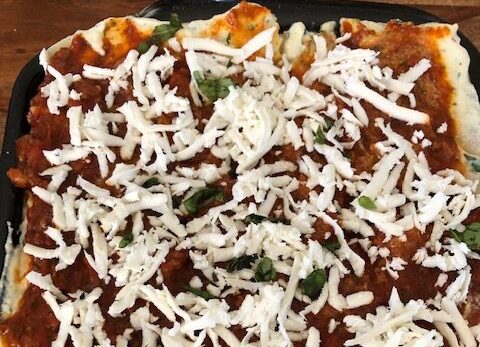
New York Style Lasagna
Ingredients
- 1 medium sweet vidalia onion, diced (my photos show a red onion, because…that's all I had!)
- 4 cloves garlic (how New York do you want it?), minced
- 1 red pepper, diced (optional if for a more peppery sauce)
- 1 small carrot, peeled and diced (optional for a more Euro flair, but you can simply add a small chunk of carrot or a teaspoon of sugar if you're a GoodFella.)
- 1 lb ground beef/ground pork (2 parts beef to one part pork, but you can play with the ratio and add veal, etc. if preferred), salt and pepper added.
- 4 cups red wine
- 1 tbsp tomato paste
- 1 28 – oz. can of crushed tomatoes (I use Tuttorosso)
- Handful of chopped parsley and/or basil (save some basil for the top of the lasagna) lasagna)
- Red pepper flakes (for a kick), oregano, additional salt and pepper, and a bay leaf for good luck
- olive oil (my mother's favorite was Filippo Berio in a huge golden tin)
- 16 oz container ricotta (BelGioioso or Galbani are good choices)
- 2 eggs
- drizzle of olive oil
- ½ bunch parsley, chopped
- Salt and pepper, some additional red pepper
- 16 oz package of whole milk mozzarella, shredded
Method
- Salt and pepper the ground meat and add to a saucepan with a tablespoon of oil over medium heat. Brown until all the meat is lightly cooked and break up the pieces as you do so. Set aside. Drain the pan of most of the fat.

-
- In the same pot, add a touch more oil and brown the onion, pepper, carrot if using, and garlic for 5-10 minutes, until the flavors meld and the onions and peppers soften.

-
- Add the meat back in and combine for a few minutes.

-
- Turn up the heat to medium-high and add the red wine into the mix; de-glaze the pot, scraping up any bits from the bottom. Once the red wine liquid is almost gone, spoon in the tomato paste. After a minute, add the can of crushed tomatoes (or whole tomatoes if preferred).
- As the sauce comes to a boil, adjust salt/pepper levels, adding any additional red pepper flake and some oregano to taste. I add a bay leaf, because my Croatian relatives' yard in Split is peppered with bay leaf trees (my leaves are dry on this side of things) and my mother always added a bay leaf to her sauces.

-
- Once boiling, lower to a slow simmer and cover for at least 2 hours, more if you have the time of a Sicilian grandma on a Sunday.
- Shred a pile (how big do you want your cheese blanket) of mozzarella cheese (16 oz. pack of Sargento is a good basic brand, but buying the pale, unmarked, clearly wrapped ball of Italian mozzarella is absolutely more creamy.)
- As the sauce cooks,empty the ricotta into a bowl. Crack two eggs into it, add a drizzle of olive oil, along with, yes, red pepper flakes, salt, and chopped parsley. Whisk until creamy and smooth. Set aside with the shredded mozzarella.

-
- In a lasagna tray/glass baking dish, spoon a little red sauce on the bottom of the dish, spreading it around.Start with a layer of lasagna strips (trim where necessary and overlapping is a good idea.)
- Add a layer of the meat ragu, a layer of the ricotta mix, and a good sprinkle of mozzarella.

-
- Add more sauce, pasta, ricotta and mozzarella. You can end with the ragu layer, adding as much of a down comforter of mozzarella cheese as you like. You can also have added parmesan to any layer desired. On the very top of the mozzarella, you can add more parm, and some basil leaves, plus a drizzle of olive oil like a good New Yorker.

-
- Cover with foil and bake at 375 degrees for a good 35-40 minutes until the cheese is bubbling away. Remove the foil and move to the very top of the oven to broil for 5-10 minutes to achieve the perfect golden brown shade of mozzarella that you love the best.

-
- Allow to cool for at least 15-20 minutes, so that the intricate patchwork structure can set. Cut into nice, big,NY bagel/doughnut/muffin/pizza/anything sizes and enjoy.

-
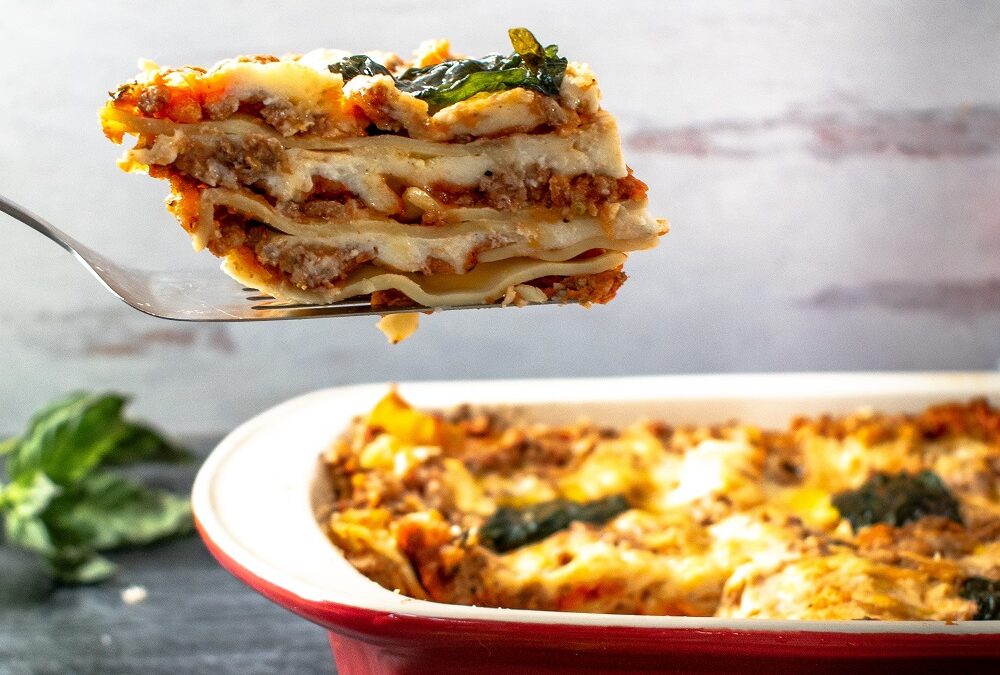
Napoli Lasagna (aka Lasagna Bolognese)
Ingredients
- 1 medium sweet vidalia onion
- 1 carrot
- 1 stalk of celery
- 1 lb ground beef/ground pork (2 parts beef to one part pork, but you can play with the ratio and add veal, etc. if preferred), salt and pepper added.
- pureed tomatoes (Pomi, 26 oz. carton or, if you can find, Mutti Tomato Puree 26 oz. jar)
- ½ cup white wine
- salt and pepper (I had to lock up my beloved garlic and red pepper flakes. It has no place here!)
- basil leaves, because why not-
- 4 cups whole milk
- ½ cup unsalted butter
- ½ cups all-purpose flour (add more if the sauce looks too thin)
- pinch nutmeg
- salt
- black pepper
- 1 cup shaved Parmigiano-Reggiano
Method
- Season the ground beef/pork with salt and pepper and combine in a bowl to mix the two flavors together. Brown in a little olive oil using a deep sauce pot on a medium heat, until no more pink remains in the meat.

-
- In the same pot, add a touch more oil and brown the onion, celery,and carrot for 5-7 minutes, then adding the meat back in and combine for a few minutes.

-
- Turn up the heat to medium-high and add the white wine into the mix; de-glaze the pot, scraping up any bits from the bottom. Once the white wine liquid is almost gone, add the jar/carton of tomato puree.

-
- As the sauce comes to a boil, adjust salt/pepper levels. I insisted on keep the bay leaf for posterity. Once boiling, lower to a slow simmer and cover for at least 2 hours or more if you feel like taking an afternoon nap.
- Warm the milk over medium-low heat, allowing it to stay just beneath a boil.
- Whisk the flour into a bowl of the room warm (not bubbling) melted butter until smooth.
- Place the butter/flour mixture into a sauce pan on a lower heat and add the warmed milk,nutmeg, salt and pepper. Stir steadily with a big whisk. It seems impossible at this point that the thin milk mixture will ever thicken, but if you keep at it (it took me almost 15 minutes and some sore forearms), the bechemel will soon thicken and look like a cheese mixture, even though there is no cheese in the mix.
- In a lasagna tray/glass baking dish, spoon a little bechemel ("besciamella,"actually) on the bottom of the dish, spreading it around. Add a layer of the meat ragu and then a layer of lasagna strips (trim where necessary and overlapping is a good idea). Repeat, adding more besciamella, ragu, and lasagna.

-
- Over each layer of besciamella, shave as much Parmigiano-Reggiano as you like; don't lose your mind…this is Italy, not Mulberry Street.

-
- End with the besciamella layer, topped with the ragu, and more Parmigiano-Reggiano. For good measure, I still added some fresh basil leaves for color and couldn't resist that drizzle of olive oil.

-
- Bake at 375 degrees for about 30 minutes; no browning cheese blanket step necessary.

-

